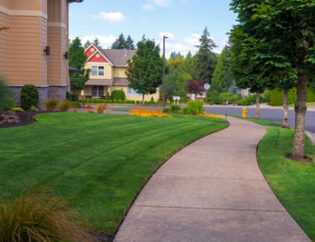 Most of us know how important water is for keeping our lawns and landscapes healthy and green. Without water, our grass and plants can’t survive. Automatic irrigation systems can provide great care for a lawn. They eliminate hose pulling and can do your watering chores anytime, even when you’re asleep or out of town. But even with the most sophisticated sprinklers, you could still be sending money down the drain if it’s not used correctly.
Most of us know how important water is for keeping our lawns and landscapes healthy and green. Without water, our grass and plants can’t survive. Automatic irrigation systems can provide great care for a lawn. They eliminate hose pulling and can do your watering chores anytime, even when you’re asleep or out of town. But even with the most sophisticated sprinklers, you could still be sending money down the drain if it’s not used correctly.
Without proper watering procedures, even the best lawn care services will end up going to waste. No amount of fertilizer or weed control can help a lawn that isn’t receiving proper hydration. Read on to find out how to keep your yard healthy and hydrated.
Getting coverage and depth is the first step.
Your lawn needs 1 to 2” of water a week. That’s about 600-900 gallons per 1,000 square feet of grass. That’s a lot of water and you don’t want to waste any of it. The first step is to know when (and how) to turn your system off. That’s right. We see sprinklers going full blast in the middle of rainstorms and wonder if the folks are asleep, or if they don’t have a master switch for their system. You need to know how much rainfall you’re getting to know when your system needs to run, and when it can be turned off for awhile. Keeping in mind how much water your lawn needs, and setting the timers on your system, will determine how deeply you are watering.
There are also rain sensors that can be installed to shut off your system if it’s raining. In addition with modern technology you can install a wi-fi controller that is connected to weather stations to help prevent over watering.
A big temptation with automatic systems is to water the lawn for a short time every day or two. This results in shallow watering and shallow, weak roots.
Responsible turf care means taking care to ensure that all of the lawn is getting watered. Each type of sprinkler head has a different pattern and flow rate. If your system is properly designed, it is divided into zones that cover all of the turf and planting beds on your property.
Most in-ground sprinkler systems today are efficient and precise. But regular, minor adjustments to these automated systems can lead to major improvements in how well they work:
- Check sprinkler heads periodically to make sure none have been jostled, and are still aimed in the right directions.
- Be sure sprinklers have an even spray pattern, and that leaves or other debris aren’t blocking the spray as your landscape grows.
- Keep an eye out for any damaged sprinkler heads.
- Make sure your timer is adjusted correctly for the season.
- Follow manufacturer instructions for winterizing your system each year. For many systems, this means blowing out pipes so water that can freeze will not do any damage.
- Consider drip systems for deep roots. They deliver water very slowly so it can penetrate.
We know how important water is to everything we do at Shamrock Pest And Lawn. We want you to get the most from your system, have a beautiful turf, and not waste water or money. So if you have any questions, contact your neighborhood lawn professional today.





